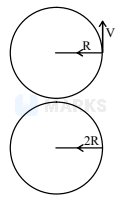Search any question & find its solution
Question:
Answered & Verified by Expert
A car goes around uniform circular track of radius $R$ at a uniform speed $v$ once in every $T$ seconds. The magnitude of the centripetal acceleration is $\mathrm{a}_{\mathrm{c}}$ If the car now goes uniformly around a larger circular track of radius $2 R$ and experiences a centripetal acceleration of magnitude $8 \mathrm{a}_{c}$, then its time period is
Options:
Solution:
1855 Upvotes
Verified Answer
The correct answer is:
$T / 2$

$\mathrm{T}=\frac{2 \pi \mathrm{R}}{\mathrm{V}}$
$\mathrm{a}_{\mathrm{C}}=\frac{\mathrm{V}^{2}}{\mathrm{R}}$
$8 \mathrm{a}_{\mathrm{C}}=\frac{\mathrm{V}^{\prime 2}}{2 \mathrm{R}}$
(8) $\frac{\mathrm{V}^{2}}{\mathrm{R}}=\frac{\mathrm{V}^{\prime 2}}{2 \mathrm{R}}$
$\mathrm{V}^{\prime 2}=16 \mathrm{~V}^{2}$
$\mathrm{~V}^{\prime}=4 \mathrm{~V}$
$\therefore$ Time period $=\frac{(2 \pi) \mathrm{R}^{\prime}}{\mathrm{V}^{\prime}}$
$=\frac{(2 \pi) 2 \mathrm{R}}{4 \mathrm{~V}}$
$=\frac{\pi \mathrm{R}}{\mathrm{V}}$
$=(\mathrm{T} / 2)$
Looking for more such questions to practice?
Download the MARKS App - The ultimate prep app for IIT JEE & NEET with chapter-wise PYQs, revision notes, formula sheets, custom tests & much more.